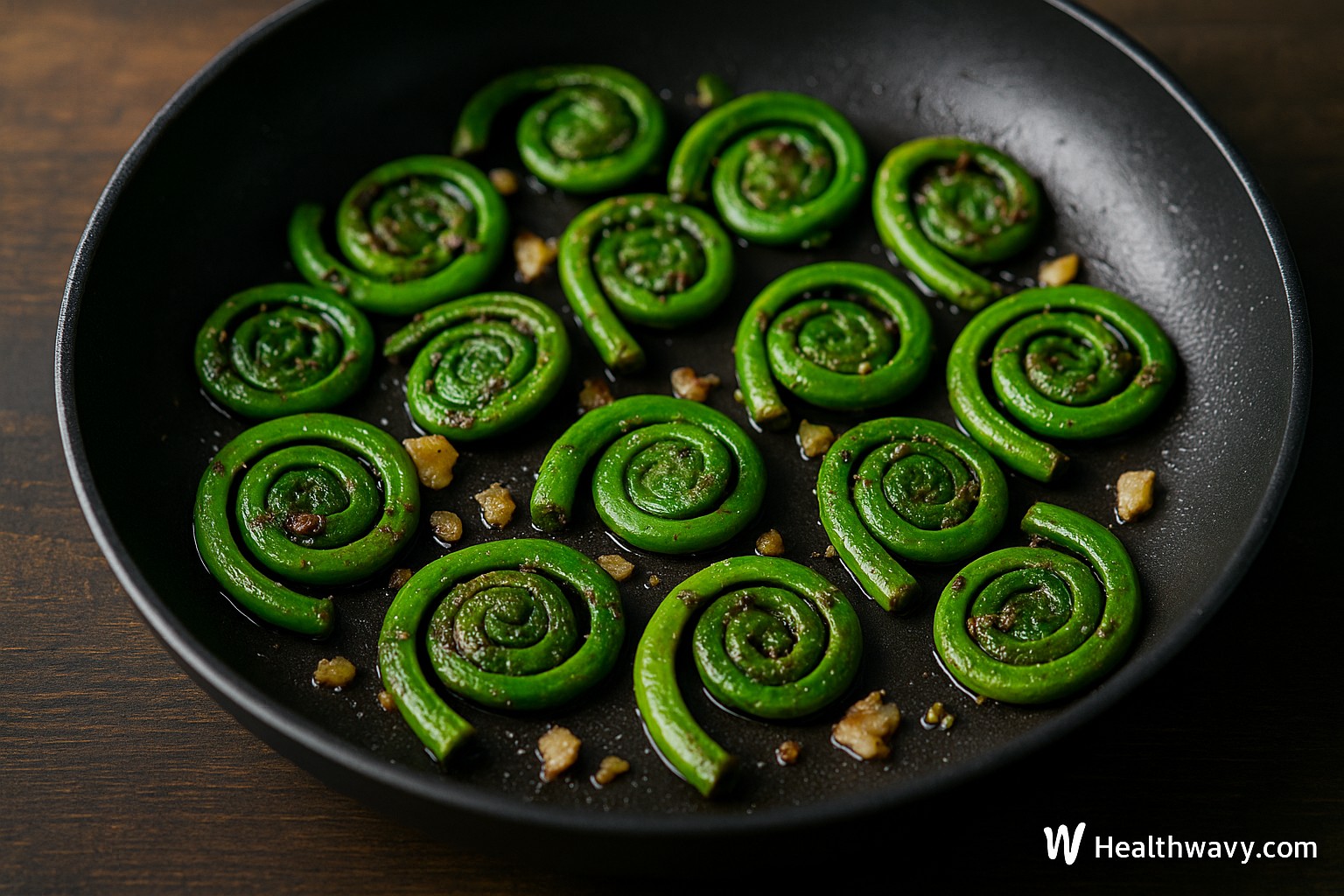Fiddlehead ferns grow in moist woods during early spring. Their curled green tops look like a violin’s head. That shape gave them their name. The coils stay tight for a short time. After they open, the plant turns tough and bitter. This short window makes them a rare spring treat.
In many cultures, fiddleheads signal the start of the harvest season. In North America, most come from ostrich ferns. These grow near rivers, streams, and shaded forest trails. People pick them wild or buy them fresh from local markets.
Fiddleheads taste fresh and earthy. Some say they remind them of asparagus. Others think they taste more like spinach with a crunch. Their flavor draws people in, but many eat them for health benefits too.
Still, not everyone feels sure. Some worry about food safety. Others ask if they are safe during pregnancy. Some want to know what natural health systems like Ayurveda say. This guide answers all of that. It explains the benefits, the risks, and the right way to cook fiddleheads.
What Do Fiddlehead Ferns Taste Like?
Fiddlehead ferns have a clean, earthy taste. Many say they taste like asparagus mixed with spinach. Some notice a nutty or grassy flavor that feels fresh and light. When cooked right, they have a soft crunch that adds life to any meal.
The flavor depends on how fresh they are. Young, tight coils taste mild and sweet. Older or overcooked ones turn bitter and lose their crisp bite. Fresh fiddleheads give a bright green color and smell that hint at spring freshness.
Their flavor blends well with butter, garlic, or lemon. Simple seasoning keeps their natural taste alive. That mild flavor makes them easy to pair with eggs, rice, soups, or fish.
Where to Buy Fiddlehead Ferns

Fiddlehead ferns appear for a short time each spring. You can find them in farmers’ markets, local co-ops, or natural food stores. In the United States, they often come from Maine, Vermont, and the Pacific Northwest. In Canada, they are popular in New Brunswick and Quebec.
Some grocery stores carry them fresh for only a few weeks. After that, frozen ones become easier to find. Many online stores sell frozen ostrich ferns that stay safe and keep their flavor.
Fresh fiddleheads should look tight and green, not soft or brown. Always check the label or ask the seller to confirm they are ostrich ferns. Price depends on the season and location but usually ranges from six to ten dollars per pound.
What Nutrients Do Fiddlehead Ferns Contain?
Fiddlehead ferns give many nutrients with few calories. One cup of cooked ferns provides fiber, iron, vitamin A, and vitamin C. You also get manganese, potassium, copper, and B vitamins.
- Vitamin A keeps eyes clear and skin strong.
- Vitamin C supports healing and helps the body use iron.
- Iron moves oxygen through the blood.
- Potassium supports heart rhythm and muscle use.
- Fiber improves digestion and bowel flow.
Fiddleheads also give omega-3 and omega-6 fats. These help the heart and brain. Most greens do not have them, which makes fiddleheads stand out.
They also have antioxidants. These protect cells from damage and lower risk of disease. You also stay full longer, which may help with weight control.
You can also explore other nutrient-packed plant foods like tahini in this guide.
Fiddlehead Ferns VS Other Greens
Fiddlehead ferns match many leafy greens in value but still stand apart. They have more vitamin A and C than spinach and about the same iron as kale, They also give omega-3 fats, which most greens do not offer.
They are lower in calories than kale or chard and their fiber level keeps digestion steady, and their antioxidants protect cells from damage. This makes fiddleheads a strong choice for anyone who wants fresh, nutrient-rich food with less bulk.
Main Health Benefits of Eating Fiddlehead Ferns

Fiddlehead ferns support many parts of the body. They give you key vitamins, minerals, and healthy fats in one small serving. These benefits can help you feel stronger, sharper, and more balanced.
Clear Eyes and Smooth Skin
Vitamin A keeps your eyesight strong. It protects your eyes from dryness and damage. It also builds new skin cells and keeps your skin firm, moist, and clear.
Stronger Immune System
Vitamin C helps your body fight off germs. It builds white blood cells and helps wounds heal. This support lowers the risk of colds and other infections.
Easier Digestion
Fiber keeps your stomach and bowels working well. It helps move waste through your system and eases bloating. Regular fiber also supports a healthy gut.
A Stronger Heart
Potassium helps your heartbeat stay steady. It also balances fluids and lowers strain on your heart. The omega-3 fats in fiddleheads reduce inflammation and support clear arteries.
Cell Protection from Damage
Fiddleheads contain antioxidants that protect your body’s cells. These fight stress inside the body and lower your risk of illness. They may also help slow signs of aging.
Are Fiddlehead Ferns Safe to Eat?
Yes, but only when fully cooked. Raw fiddleheads can upset your stomach. Some people felt cramps, nausea, or vomiting after eating them raw.
Boil them first in clean water for 10 to 15 minutes. This step removes toxins and kills harmful bacteria. Once boiled, you can sauté, roast, or mix them into other dishes. Never skip the boiling step.
Stick to ostrich ferns. These are the safest type. Avoid bracken ferns. They may contain a toxin called ptaquiloside. Some research links this compound to cancer. Experts say you should not eat bracken at all.
Choose fiddleheads that look fresh and bright green. Avoid any that feel slimy or smell bad. Rinse them in cold water and remove any brown skin. Use them within two days for the best taste and safety.
Can You Eat Fiddlehead Ferns Raw?
No, raw fiddlehead ferns are not safe. They can carry natural toxins and harmful bacteria. Eating them raw may cause cramps, nausea, or diarrhea. The Centers for Disease Control and Prevention once noted several sickness cases from raw ferns.
Cooking is the only safe way. Boil them in clean water for at least 10 to 15 minutes. This step removes toxins and makes them safe to eat. Sautéing or steaming alone is not enough. Always boil first, then cook them however you like.
Can Pregnant Women Eat Fiddlehead Ferns?
Pregnant women can eat fiddlehead ferns, but only when fully cooked. Raw ferns may carry toxins that harm the mother or the baby. Boiling removes these risks and makes the food safe.
Fiddleheads offer strong nutrition in a small amount. They give iron, folate, vitamin C, and fiber. Iron keeps blood strong and moves oxygen to the baby. Folate supports brain and spine growth in early months. Vitamin C strengthens the immune system and helps your body use iron. Fiber keeps digestion smooth and may ease constipation.
These ferns also help with hunger control. They are low in calories but make you feel full. That may help reduce the urge to snack. It also supports steady, healthy weight gain during pregnancy.
Always pick fresh fiddleheads from clean sources. Boil them before eating. Speak with your doctor before trying them, especially during your first trimester.
Fiddlehead Ferns in the Third Trimester
During the final months of pregnancy, the body needs more nutrients. Fiddleheads give iron, potassium, and fiber that support this need.
Iron helps fight fatigue. Potassium helps reduce swelling in the feet and hands. Fiber keeps digestion smooth and regular.
Fiddleheads also support light, frequent meals. They go well with rice, beans, eggs, or broth. They add volume and flavor without heavy fat.
Their soft taste blends with many healthy foods. They support balanced meals without bloating or heartburn.
What Does Ayurveda Say About Fiddleheads?
Ayurveda sees fiddlehead ferns as seasonal food with cleansing power. Their bitter and dry taste removes mucus and heat from the body.
These ferns help the liver clean the blood. They support skin health and may raise energy after winter. In Ayurveda, food should match the season. Fiddleheads fit spring diets.
Add warm spices to make digestion easier. Cumin, turmeric, and black pepper work well with them. Always eat them cooked.
Eat small portions. See how your body reacts. Ayurveda values balance more than quantity.
Who Should Avoid Fiddlehead Ferns
Most people can eat fiddlehead ferns safely when cooked. Still, a few groups should be cautious. People with plant allergies should check with a doctor first. Anyone with stomach or digestion problems should start with a small portion.
Pregnant women should eat only boiled ferns and in moderate amounts. People unsure of the fern type should avoid wild ones. Never eat ferns that you cannot identify. Children should also eat small portions because their stomachs are more sensitive.
Possible Side Effects to Know

Fiddlehead ferns are safe when prepared the right way. Raw or poorly cooked ferns may cause stomach trouble. Many people felt sick after eating them without boiling.
Common side effects include stomach pain, cramps, vomiting, or diarrhea. These issues happen more often when the ferns are raw or undercooked.
Some people may also have mild allergies. This is rare but still possible. Others may feel sick after eating wild ferns that are not true ostrich ferns. Some wild types look similar but carry toxins.
Eating too much in one meal can also cause discomfort. Start with a small amount. See how your body reacts. If you feel fine, you can try more next time.
Always boil fiddleheads for safety. Use only ostrich ferns from trusted sources. Handle them with care, and you can enjoy them without worry.
Fiddleheads are rich in vitamins, fiber, and healthy fats. You can also explore protein-rich plant foods in this Mannacote Nutrition Guide.
Are All Ferns Safe to Eat?
No. Most ferns are not edible. Ostrich ferns are the safest and most trusted.
Bracken ferns may carry toxins. These do not go away even after cooking. Some studies link bracken to cancer. Avoid them.
Some unsafe ferns look like ostrich ferns. That can confuse people. Do not take chances. Only eat what you can name with confidence.
Are Fiddlehead Ferns Toxic to Dogs or Cats?
Pets should not eat fiddlehead ferns. There is not enough research to prove they are safe for animals. Some ferns may upset a pet’s stomach or cause vomiting.
Cooked ferns can also harm pets because they may have butter, salt, or oil. These cause digestion issues in dogs or cats. Keep all fern dishes away from pets, and call a vet if your pet eats any by mistake.
Can You Grow Fiddlehead Ferns at Home?
Yes, you can grow ostrich ferns in your garden. They grow best in shady, moist soil that drains well. They need cool air, gentle light, and steady water. The best place is near a wall or tree where the soil stays damp but not soggy.
It takes patience. You may wait two to three years before you can harvest the first young shoots. Never pick all the coils from one plant. Leave a few each time so the fern stays strong for next spring.
Once they start growing each year, harvest only the tight green coils. Wash them right away and cook them soon after. Homegrown fiddleheads can be as fresh and rich as wild ones if handled with care.
How to Prepare and Cook Fiddlehead Ferns

Fiddlehead ferns need the right prep before eating. Raw ones are not safe. Cooking makes them safe and brings out their taste.
Start by rinsing the ferns under cool water. Remove any brown flakes or skin. Look for firm, bright green coils with no slimy texture.
Boil the ferns in clean water for 10 to 15 minutes. This step removes toxins and kills bacteria. Do not skip the boil.
After boiling, let them drain and dry. You can then sauté them in butter or oil. Add garlic, salt, lemon, or pepper to boost the flavor.
Serve them warm. Fiddleheads go well with rice, eggs, or broth-based meals. You can also freeze boiled ferns to use later.
Always eat them cooked. Use fresh ones within two days for the best results.
🧑🍳 Your Fiddlehead Experience
Have you ever tried cooking fiddlehead ferns at home? Did it turn out great-or not so great?
Maybe your grandmother made them every spring? Or you tried them at a restaurant?
We’d love to hear your story! Share your experience in the comments or send us a message. Your tip might help someone new enjoy this wild veggie the right way.
Fiddlehead Fern Recipes to Try
Fiddleheads work well in simple meals. Their mild taste fits with many common foods. Here are a few easy ideas:
Cooked fiddleheads taste great with scrambled eggs and herbs.
You can add them to rice bowls with garlic and lemon.
Mix boiled ferns with mushrooms and olive oil for a light side dish.
Toss them with butter and sprinkle cheese for a rich flavor.
Blend them into soup with onions, potatoes, and broth for a spring-style meal.
Each recipe starts with boiled ferns. Keep the seasoning light so their natural flavor stands out.
How to Store Fiddlehead Ferns Safely
Fiddlehead ferns spoil fast if left out. Keep them cold to stay safe. Wrap fresh ferns in a clean paper towel and place them in an open plastic bag. Store them in the refrigerator for up to two days.
If you plan to keep them longer, boil them first. Let them cool, then spread them on a tray to dry. Place them in a freezer-safe bag and label it with the date. Frozen boiled fiddleheads stay good for up to a year.
Avoid storing them raw or wet. Moisture causes them to spoil faster. Always check for any bad smell before use.
Fun Facts and Cultural History

Fiddlehead ferns have been part of traditional diets for centuries. People in Japan, Nepal, and Canada have eaten them since ancient times. In North America, they became a spring delicacy in Maine and eastern Canada.
The name “fiddlehead” comes from the shape of the coiled top. It looks like the scroll of a violin. Many cultures saw it as a symbol of renewal and new life after winter. Some old remedies used them to cleanse the body and restore strength.
Today, they remain a seasonal favorite across homes and restaurants. Their short harvest season keeps them special every spring.
Final Thoughts
Fiddlehead ferns are a smart seasonal food. They give real health value without extra calories. You get support for your heart, skin, gut, and immune system. They also help during pregnancy and match well with spring diets in Ayurveda.
Still, they need care. Pick the right type. Always cook them well. Start with small portions and see how your body reacts.
These wild greens are more than a food trend. People have eaten them for centuries. With the right prep, they bring both flavor and strength to your table. Handle them with respect, and they may earn a place in your seasonal meals year after year.
Their rich mix of nutrients makes them stand out among other greens. You can compare their wellness impact with Insoya products in this guide.
Frequently Asked Questions
| Question | Answer |
|---|---|
| Can you eat fiddlehead ferns raw? | Raw fiddleheads may carry harmful bacteria and natural toxins. Always boil them first to make them safe. |
| How long do fresh fiddlehead ferns last? | Fresh ferns stay safe in the fridge for up to two days. Use them quickly for best taste and texture. |
| Are fiddlehead ferns good for weight loss? | Fiddleheads are low in calories and high in fiber. They help you feel full and may support healthy weight control. |
| What is the best way to cook fiddlehead ferns? | Boil them in clean water for 10 to 15 minutes. Then sauté or roast them with mild seasoning. |
| Can children eat fiddlehead ferns? | Children can eat small amounts of fully cooked fiddleheads. Start with a few pieces and watch for any reaction. |
| Are fiddlehead ferns safe during pregnancy? | Cooked fiddleheads are safe for most pregnant women. Always speak to a doctor before trying them for the first time. |
| Do fiddlehead ferns taste like asparagus? | Many people say fiddleheads taste like a mix of asparagus and spinach. Their flavor is fresh with a light crunch. |
| Are all types of ferns safe to eat? | No. Only certain kinds like ostrich ferns are safe. Others, like bracken ferns, may contain toxins. |
| Can I freeze fiddlehead ferns? | Yes. Boil them first, cool them down, and then freeze in airtight bags for later use. |
| What season can you find fiddlehead ferns? | Fiddlehead ferns grow in early spring. Their harvest window is short, lasting just a few weeks each year. |
Disclaimer: The information in this guide is for general knowledge and educational use. It does not replace medical or professional advice. Always talk with your doctor or a qualified health expert before adding new foods to your diet. Fiddlehead ferns must be fully cooked before eating. The author and publisher are not responsible for any harm caused by unsafe preparation or wild plant use. Eat safe, stay informed, and enjoy responsibly.





